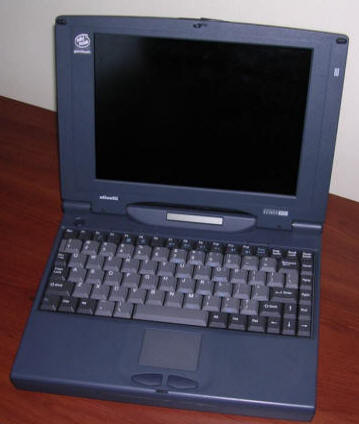Olivetti Echos P75 (Model 860c)
Small notebook with touchpad (which was
quite new technology in mid-90s), color LCD, sound card and Pentium
processor. It has 8MB of RAM on board, RAM can be expanded by SIMM
modules.
Not much is known about this notebook, but I found it has some
legacy technologies, such as RTC battery soldered to mainboard (WILL
LEAK!) or sound card in external module (in 1995 most notebooks had
sound chip soldered in mainboard) and some new things in this class,
e.g. bay for replaceable drives.
This computer has one problem, described in some web sites: Many units today suffer the "white screen" problem. some users think that it's a oscillator-related problem, I think it's connected to corrupted settings flash memory. This memory corrupts frequently and information about screen contrast, brightness and source selection is lost, making white screen (increasing contrast manually resets it to very dark, then brighter) and may even hang system at boot (BIOS can't read what's connected to display part).
| Manufacturer | Olivetti | |
| Origin | Italy | |
| Year of unit | 1995 | |
| Year of introduction | 1994? | |
| Type | Laptop, PC | |
| CPU | Intel Pentium, 75MHz | |
| RAM | 8MB onboard +16MB SIMM | |
| Floppy Disk | 1x 3.5" 1.44MB in a bay. | |
| Hard Disk | Originally 1.2GB | |
| Other media | [with expansion bay] | |
| Graphics and display: | DSTN Color LCD 640x480x16bit Card: Chips 65545 |
|
| Sound: | PC Speaker,
ESS ES1688 sound card |
|
| Keyboard and pointing device: | Small PC keyboard without numeric
part Touchpad. |
|
| OS: | Windows 95/98 | |
|
Power supply:
1 - Ground |
||
| I/O: | - Serial port - Parallel port - VGA out - Sound I/O - 2x PCMCIA - Drive expansion bay - Dock connector - PS/2 connector |
|
| Possible upgrades: | Memory (2 SIMMs), CPU (Socket 5). | |
| Additional peripherals: | none |
Echos P75 has quite modern BIOS with Setup, but BIOS support battery (2,4V rechargeable) must be removed and substituted with something else or it'll leak and damage mainboard.
Unfortunately I can't say more about this computer because I don't have HDD cable for it. It needs 1:1 cable with male-female connectors. Male goes to mainboard, female to hard disk.
To disassemble:
0. Remove battery, hard disk, floppy/CD.
1. Open notebook, pull out two plastic tabs on the top of keyboard.
2. Open keyboard towards you, carefully pull keyboard's ribbon cable from
connector. After removing screw remove shielding/heatsink.
3. Remove sound card from mainboard by removing two nuts from Mic/speaker
connectors, then remove the card out the mainboard. You may leave it
floating on cables.
Now you can replace CPU (in Socket 5) but if you put
something more than Pentium 133MHz it'll overheat. After you changed CPU
remember to change DIP switches which can be found under sound card (CPU
freq = Bus freq * multiplier):
| Switch 1 | Switch 2 | Bus freq [MHz] | Switch 3 | Switch 4 | Multiplier | |
| OFF | OFF | 60 | OFF | OFF | 1,5x | |
| OFF | ON | 66 | OFF | ON | 3x | |
| ON | OFF | 20 | ON | OFF | 2x | |
| ON | ON | 50 | ON | ON | 2,5x |
In some cases BIOS may display all settings >=100MHz as "Pentium 100MHz", but speed will be as set by switches.
4. Now we have to remove a whole top part - Remove one
screw, in bottom-left of keyboard hole, now flip the computer and remove
all bottom screws (4 or 5?). Carefully unlatch and separate top part
from bottom, disconnect touchpad cable from mainboard.
5. Now you can take bottom part, remove RTC battery and replace it with
something better. You have some space near PCMCIA slot, so you can
solder diode and go with wires near expansion bay connector to the back
of PCMCIA slot where you can put another battery, original is 2.4V.
Reassembly: Remember not to shut sound card between top and bottom part. Remember about touchpad connector, keyboard connector, shield/heatsink, it's really needed.





